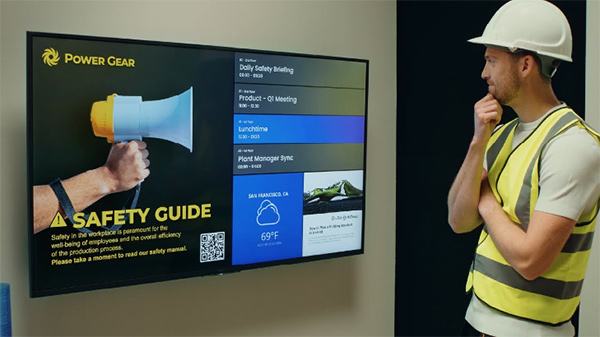Reach and engage your deskless workforce with real-time communication, boosting safety, culture, and operational efficiency.

By James Robins, CMO, Yodeck
Manufacturing is grappling with two major macro-trends: a widespread skilled labor shortage and the accelerating digitalization of industrial operations. While investments in robotics, AI, and predictive maintenance dominate headlines, there is a quieter, often overlooked imperative that deserves equal attention: effectively communicating with an increasingly deskless and distributed workforce.
According to industry estimates, deskless workers make up approximately 80% of the manufacturing workforce. These essential workers operate in environments where their ability to regularly engage with email, company intranets, or other traditional communication tools is limited by the nature of their roles. As a result, they can be the last to hear about policy changes, performance updates, or evolving production priorities.
This communication disconnect isn’t just a nuisance, it’s a risk. It can erode trust, productivity, and workplace safety. In a labor market that struggles to attract and retain talent—this is a vulnerability manufacturers can’t afford to ignore.
This is why more and more manufacturers are turning to digital signage to connect with their deskless workforce. These dynamic displays are changing how information is delivered—bringing real-time data, safety alerts, and critical updates straight to the shop floor, remote operations or even field workers.
Here are five practical ways to use digital signage in manufacturing to keep workers informed, aligned, and engaged, without relying on screens in their pockets or emails in their inboxes.
Maximizing productivity on the shop floor requires more than just tracking usual metrics like utilization, downtime, and efficiency of assets and equipment. It’s about making that data instantly accessible where decisions are made.
When you connect your production monitoring software to digital display boards, operators get real-time visibility into equipment performance. This immediate feedback loop helps operators respond more quickly and in turn reduce machine downtime.
Staying compliant with safety regulations isn’t optional, and getting the message across quickly matters. Digital displays make it easy to share critical information like emergency alerts, safety protocols, and updated step-by-step procedures in seconds.
Whether it’s a reminder to wear protective gear, a warning sign, or clear exit directions, digital screens are key to communicating safety standards in a way that’s both effective and easy to follow.
For instance, when new equipment is introduced or safety procedures change, visual instructions can be displayed on the floor, so workers know exactly what to do ensuring everyone is on the same page.
In the event of an emergency, these screens can also instantly broadcast alerts and evacuation routes, helping everyone respond quickly and confidently. Research shows this kind of real-time communication can reduce workplace injuries by up to 20%.
One of the most effective ways to keep your workforce focused and motivated is by making business goals, production quotas, and performance metrics visible to everyone on the floor.
Dynamically displaying this information in shared areas helps keep targets top of mind and reinforces how individual efforts contribute to overall success. It also helps employees adapt quickly, make informed decisions, and keep production running smoothly.
Studies show that public recognition is one of the most effective, low-cost ways to boost morale and reduce turnover. Publicly celebrating milestones, welcoming new hires, and spotlighting top performers using digital wall signs on the shop floor fosters a sense of pride and belonging. This type of activity can significantly improve morale and reduce turnover—organizations that prioritize employee recognition experience a 31% reduction in voluntary turnover rates.
Even during downtime, communication can continue in subtle and engaging ways. Break room screens can display news, company social media feeds, or company updates in a relaxed setting, helping employees feel more connected and informed outside the intensity of the shop floor. This creates a more inclusive environment and reinforces a sense of community throughout the workforce.
Training a deskless workforce often requires pulling employees away from their tasks, which can be challenging in busy environments. One way to support ongoing learning is to use digital displays to share training materials throughout the day. To boost engagement, use content, such as videos, slide decks, or PDFs, to reinforce key messages. This approach can complement traditional training by keeping important information visible and accessible during daily routines.
With 90% of information processed by the brain being visual, digital signage is a powerful tool for employee engagement on the shop floor , in the break room, or moving along the production line. These dynamic displays cut through the noise, ensuring critical information is seen, understood, and acted upon in real-time.
With remote sites and field operations, teams can be kept fully up to date through digital screens and the capability to push screen content directly to other devices, so everyone gets the message.
But just as silence can create gaps, overloading screens with too much content can create confusion. The goal should be to deliver the right information, at the right time, in the right way. To avoid fatigue and ensure messages are retained, messages should be clear, timely, and well-paced.
By approaching visual communication with intention, manufacturers can strengthen workforce engagement, improve efficiency, and promote a culture of safety, ultimately deskless workforce communication gaps, reducing turnover, and driving better performance across the board.

About the Author:
James Robins is a seasoned Chief Marketing Officer with over 20 years of experience driving high-growth strategies in both B2B and B2C markets. James is currently CMO at Yodeck, the Intelligent Digital Signage Platform™, where he leads marketing strategy and execution. Cloud-powered and designed for easy, fast adoption, Yodeck delivers the most affordable, innovative and intuitive digital signage experience, from start to finish. With more than 55,000 customers worldwide, Yodeck powers hundreds of thousands of digital screens, boosting communication power for teams in nearly every industry and across the public sector with an award-winning, industry-defining platform.
Read more from the author:
Three Keys for Creating a Successful Digital Signage Content Strategy | RetailTechnologyInsider, 12/5/24
How QSRs Can Use Digital Signage to Power Growth and Guest Engagement | QSR, 2/24/25
In this episode, I sat down with Beejan Giga, Director | Partner and Caleb Emerson, Senior Results Manager at Carpedia International. We discussed the insights behind their recent Industry Today article, “Thinking Three Moves Ahead” and together we explored how manufacturers can plan more strategically, align with their suppliers, and build the operational discipline needed to support intentional, sustainable growth. It was a conversation packed with practical perspectives on navigating a fast-changing industry landscape.